What Are the Territorial Habits of Whitetail Deer?

Whitetail deer, scientifically known as Odocoileus virginianus, are fascinating creatures that can be found across North America. These majestic animals are known for their distinctive white tail, which they raise when alarmed. While their graceful appearance is captivating, it is their territorial habits that truly intrigue wildlife enthusiasts. In this article, we will explore the territorial behaviors of whitetail deer, shedding light on their marking rituals, home ranges, and encounters with other deer.
Marking Rituals: The Scent of Ownership
One of the primary ways in which whitetail deer establish and maintain their territories is through marking rituals. These rituals involve the use of scent glands located on various parts of their bodies. The most prominent of these glands is the metatarsal gland, which is found on the inner side of their hind legs. When a deer rubs this gland against trees, shrubs, or other surfaces, it leaves behind a scent. This scent acts as a territorial marker, effectively communicating to other deer that the area is claimed.
Home Ranges: Defending Personal Space
Whitetail deer are known to have well-defined home ranges, which they defend against intruders. These home ranges can vary in size depending on the availability of resources such as food, water, and shelter. Adult bucks typically have larger home ranges compared to does and fawns. The boundaries of these ranges are marked through a combination of scent marking and physical displays such as scraping the ground with their hooves. These displays serve as visual indicators to other deer and help reinforce the territorial boundaries.
Encounters with Other Deer: Establishing Dominance
When two deer with overlapping territories come face to face, a fascinating display of dominance ensues. This encounter often begins with both deer posturing, raising their heads high and stiffening their bodies. They may also emit low-pitched vocalizations known as grunts to assert their dominance. If the posturing fails to resolve the conflict, the deer may engage in physical combat. This combat usually involves locking antlers and pushing against each other in an attempt to establish superiority. The victor of these battles often gains access to the rival’s territory and the resources within it.
Competition for Resources: Food and Mating Opportunities
Territorial habits in whitetail deer are closely tied to the competition for resources, particularly food and mating opportunities. During the breeding season, or rut, bucks become especially territorial as they seek to establish dominance and secure mating rights. They will actively patrol their territories, often engaging in scent marking to attract potential mates. Additionally, deer may also become more aggressive in defending prime feeding areas, such as lush meadows or agricultural fields.
Understanding the territorial habits of whitetail deer not only provides valuable insights into their behavior but also aids in their conservation and management. By studying their marking rituals, home ranges, and encounters with other deer, researchers can better understand population dynamics and implement effective conservation strategies. Furthermore, this knowledge can help landowners and wildlife managers in making informed decisions regarding habitat management and hunting regulations.
In conclusion, the territorial habits of whitetail deer are a marvel to behold. From their marking rituals to the defense of their home ranges, these behaviors showcase the intricacies of their social structure and survival strategies. By delving into the world of the whitetail deer, we gain a deeper appreciation for the natural wonders of our environment and the fascinating creatures that inhabit it.
